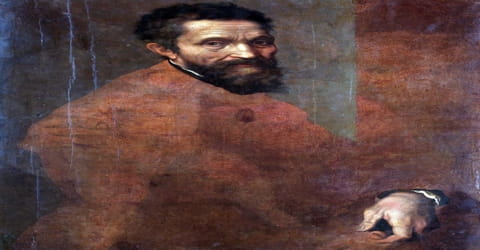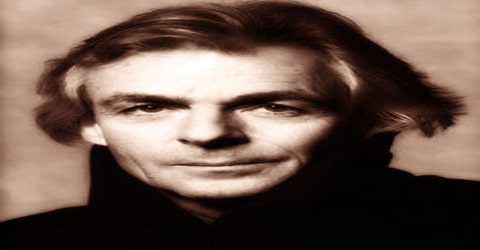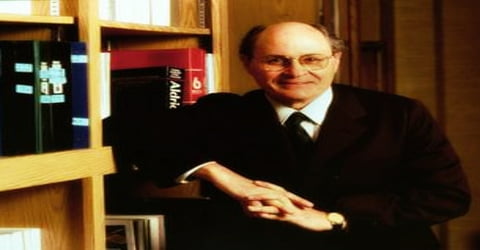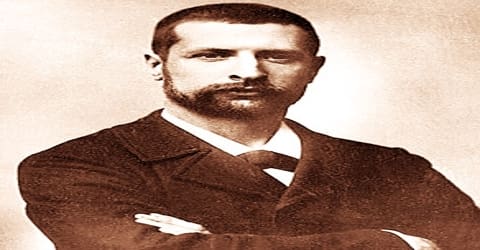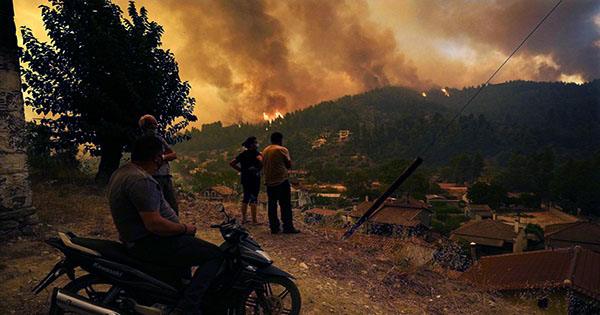Biography of Michelangelo
Michelangelo – Italian sculptor, painter, architect, and poet.
Name: Michelangelo di Lodovico Buonarroti Simoni
Date of Birth: 6 March 1475
Place of Birth: Caprese near Arezzo, Republic of Florence (present-day Tuscany, Italy)
Date of Death: 18 February 1564 (aged 88)
Place of Death: Rome, Papal States (present-day Italy)
Occupation: Sculpture, painting, architecture, and poetry
Father: Ludovico Di Leonardo Di Buonarotto Simoni
Mother: Francesca Di Neri Del Miniato Di Siena
Early Life

Michelangelo Buonarroti, Italian Renaissance sculptor, painter, architect, and poet who exerted an unparalleled influence on the development of Western art, was born on 6 March 1475 in Caprese, known today as Caprese Michelangelo, a small town situated in Valtiberina, near Arezzo, Tuscany. Considered by many the greatest artist of his lifetime, and by some the greatest artist of all time, his artistic versatility was of such a high order that he is often considered a contender for the title of the archetypal Renaissance man, along with his rival, the fellow Florentine and client of the Medici, Leonardo da Vinci.
Michelangelo is considered to be one of the greatest artists of the High Renaissance period. Born in Florence, he lived with the family of a stonecutter from the age of six after the death of his mother. Michelangelo never paid attention to schooling and instead expressed an interest in painting and later became an apprentice to a painter before studying in the sculpture gardens of the powerful Medici family. Thereafter, he started focusing on his work, creating for himself a remarkable career as a painter and sculptor in the Italian Renaissance. Two of the most significant initial works that helped him rise to eminence were the statues of ‘Pieta’ and ‘David’ which were recognized for their artistic technique. Subsequently, he was commissioned by Pope Julius II to design his tomb, a project on which he worked on for four decades.
Despite holding a low opinion of painting, he also created two of the most influential frescoes in the history of Western art: the scenes from Genesis on the ceiling of the Sistine Chapel in Rome, and The Last Judgment on its altar wall. His design of the Laurentian Library pioneered Mannerist architecture. At the age of 74, he succeeded Antonio da Sangallo the Younger as the architect of St. Peter’s Basilica. He transformed the plan so that the western end was finished to his design, as was the dome, with some modification, after his death. He was the first Western artist whose biography was published while he was alive. In fact, two biographies were published during his lifetime. One of them, by Giorgio Vasari, proposed that Michelangelo’s work transcended that of any artist living or dead, and was “supreme in not one art alone but in all three”.
Meanwhile, after receiving much appreciation for his sculpted works, he was commissioned to design the ceiling of Rome’s Sistine Chapel, a project which fueled his imagination to produce one of the most influential works in the history of Western Art. Some of his other major works include the design of ‘Medici Chapel’ and ‘Laurentian Library’, and the painting of ‘Last Judgment’ on the altar wall of the Sistine Chapel which is considered a masterpiece. Michelangelo was the greatest artist of his time and his name has become synonymous with the best of the Italian Renaissance.
Childhood, Family and Educational Life
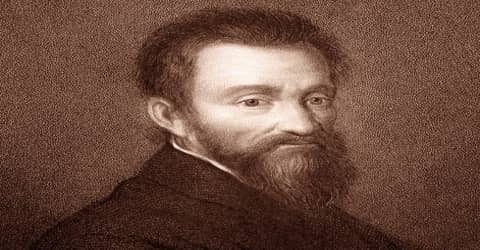
Michelangelo, in full Michelangelo di Lodovico Buonarroti Simoni, was born on March 6, 1475, in Caprese, Italy, to Leonardo di Buonarrota Simoni, a magistrate in the small village, and his wife, Francesca Neri. Michelangelo was the second of five sons in the family. The family moved back to Florence before Michelangelo was one month old. Michelangelo’s mother died when he was six. From his childhood, Michelangelo was drawn to the arts, but his father considered this pursuit below the family’s social status and tried to discourage him.
As a young boy, Michelangelo was sent to Florence to study grammar under the Humanist Francesco da Urbino. However, he showed no interest in his schooling, preferring to copy paintings from churches and seek the company of other painters. However, Michelangelo prevailed and was apprenticed (worked to learn a trade) at the age of thirteen to Domenico Ghirlandaio (1449–1494), the most fashionable painter in Florence at the time.
From 1489 to 1492, Michelangelo spent time with the Medici family which helped him meet the social elite of the city, exposing him to prominent poets and scholars. During this period, he sculpted the reliefs ‘Madonna of the Steps’ (1490–1492) and ‘Battle of the Centaurs’ (1491–1492), the latter based on a theme suggested by Poliziano and commissioned by Lorenzo de Medici.
Personal Life

Michelangelo was a devout Catholic whose faith deepened at the end of his life. His poetry includes the following closing lines from what is known as poem 285 (written in 1554); “Neither painting nor sculpture will be able any longer to calm my soul, now turned toward that divine love that opened his arms on the cross to take us in.”
It is impossible to know for certain whether Michelangelo had physical relationships (Condivi ascribed to him a “monk-like chastity”), but the nature of his sexuality is made apparent in his poetry. He wrote over three hundred sonnets and madrigals. The longest sequence displaying a great romantic friendship was written to Tommaso dei Cavalieri (c. 1509–1587), who was 23 years old when Michelangelo met him in 1532, at the age of 57.
In 1542, Michelangelo met Cecchino dei Bracci who died only a year later, inspiring Michelangelo to write forty-eight funeral epigrams. Some of the objects of Michelangelo’s affections, and subjects of his poetry took advantage of him: the model Febo di Poggio asked for money in response to a love poem, and a second model, Gherardo Perini, stole from him shamelessly.
Late in life, Michelangelo nurtured a great platonic love for the poet and noble widow Vittoria Colonna, whom he met in Rome in 1536 or 1538 and who was in her late forties at the time. They wrote sonnets for each other and were in regular contact until she died. These sonnets mostly deal with the spiritual issues that occupied them. Condivi recalls Michelangelo’s saying that his sole regret in life was that he did not kiss the widow’s face in the same manner that he had her hand.
Career and Works

In 1492, after the death of Lorenzo, the Medici family fell from power, causing him to flee to Bologna where he continued his studies. Michelangelo left the security of the Medici court and returned to his father’s house. In the following months, he carved a polychrome wooden Crucifix (1493), as a gift to the prior of the Florentine church of Santo Spirito, which had allowed him to do some anatomical studies of the corpses from the church’s hospital. Between 1493 and 1494 he bought a block of marble and carved a larger than life statue of Hercules, which was sent to France and subsequently disappeared sometime in the 18th century. On 20 January 1494, after heavy snowfalls, Lorenzo’s heir, Piero de Medici, commissioned a snow statue, and Michelangelo again entered the court of the Medici.
In 1494, Michelangelo carved three saints for the church of San Domenico. Towards the end of 1494, the political situation in Florence was calmer. The city, previously under threat from the French, was no longer in danger as Charles VIII had suffered defeats. Michelangelo returned to Florence but received no commissions from the new city government under Savonarola. He returned to the employment of the Medici. During the half year he spent in Florence, he worked on two small statues, a child St. John the Baptist and a sleeping Cupid. According to Condivi, Lorenzo di Pierfrancesco de’ Medici, for whom Michelangelo had sculpted St. John the Baptist, asked that Michelangelo “fix it so that it looked as if it had been buried” so he could “send it to Rome … pass it off as an ancient work and … sell it much better.”
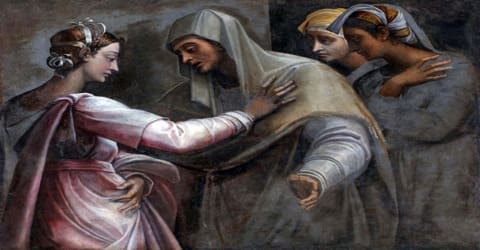
The master and Michelangelo (1843)
In 1495, Michelangelo returned to Florence and began his work as a sculptor. During the half year he spent in Florence, he worked on two small statues, a child ‘St. John the Baptist’ and a sleeping Cupid. Impressed by the quality of his design, Cardinal Raffaele Riario invited him to Rome and commissioned him to work on a statue of the Roman wine god Bacchus.
Michelangelo arrived in Rome 25 June 1496 at the age of 21. On 4 July of the same year, he began work on a commission for Cardinal Raffaele Riario, an over-life-size statue of the Roman wine god Bacchus. Upon completion, the work was rejected by the cardinal, and subsequently entered the collection of the banker Jacopo Galli, for his garden.
In 1497, Michelangelo was commissioned by Cardinal Jean de Bilhères-Lagraulas to work on ‘Pieta’, a sculpture showing the Virgin Mary grieving over the body of Jesus, which is currently located in St. Peter’s Basilica, Vatican City.
In November 1497, the French ambassador to the Holy See, Cardinal Jean de Bilhères-Lagraulas, commissioned him to carve a Pietà, a sculpture showing the Virgin Mary grieving over the body of Jesus. The subject, which is not part of the Biblical narrative of the Crucifixion, was common in religious sculpture of Medieval Northern Europe and would have been very familiar to the Cardinal. The contract was agreed upon in August of the following year. Michelangelo was 24 at the time of its completion. It was soon to be regarded as one of the world’s great masterpieces of sculpture, “a revelation of all the potentialities and force of the art of sculpture”. Contemporary opinion was summarised by Vasari: “It is certainly a miracle that a formless block of stone could ever have been reduced to a perfection that nature is scarcely able to create in the flesh.” It is now located in St Peter’s Basilica.
In 1498 the same banker commissioned Michelangelo to carve the Pietà now in St. Peter’s. The term pietà refers to a type of image in which Mary supports the dead Christ across her knees. Larger than life-size, the Pietà contains elements which contrast and reinforce each other: vertical and horizontal, cloth and skin, alive and dead, female and male.
In 1499, Michelangelo returned to Florence again but this time as an art star. He was recognized as the most talented sculptor of Italy and was commissioned to carve a statue of ‘David’. He turned a huge piece of marble into a dominating figure which was placed on the gable of Florence Cathedral.
The artist’s prominence, established by this work, was reinforced at once by the commission (1501) of the David for the cathedral of Florence. For this huge statue, an exceptionally large commission in that city, Michelangelo reused a block left unfinished about 40 years before. The modeling is especially close to the formulas of classical antiquity, with a simplified geometry suitable to the huge scale yet with a mild assertion of organic life in its asymmetry. It has continued to serve as the prime statement of the Renaissance ideal of perfect humanity.
On Michelangelo’s return to Florence in 1501 he was recognized as the most talented sculptor of central Italy. He was commissioned to carve the David for the Florence Cathedral. His Battle of Cascina was commissioned in 1504; several sketches still exist. The central scene shows a group of muscular soldiers climbing from a river where they had been swimming to answer a military alarm. This fusion of life with colossal grandeur henceforth was the special quality of Michelangelo’s art.
Also during this period, Michelangelo was commissioned by Angelo Doni to paint a “Holy Family” as a present for his wife, Maddalena Strozzi. It is known as the Doni Tondo and hangs in the Uffizi Gallery in its original magnificent frame, which Michelangelo may have designed. He also may have painted the Madonna and Child with John the Baptist, known as the Manchester Madonna and now in the National Gallery, London.
From this time on, Michelangelo’s work consisted mainly of very large projects that he never finished. He was unable to turn down the vast commissions of his great clients which appealed to his preference for the grand scale. Pope Julius II (1443–1513) called Michelangelo to Rome in 1505 to design his tomb, which was to include about forty life-size statues. Michelangelo worked on the project off and on for the next forty years. It is located in the Church of San Pietro in Vincoli in Rome and is most famous for the central figure of Moses, completed in 1516. Of the other statues intended for the tomb, two, known as the Rebellious Slave and the Dying Slave, are now in the Louvre.

The Sistine Chapel Ceiling (1508–1512)
During the same period, Michelangelo painted the ceiling of the Sistine Chapel, which took approximately four years to complete (1508–1512). According to Condivi’s account, Bramante, who was working on the building of St. Peter’s Basilica, resented Michelangelo’s commission for the pope’s tomb and convinced the pope to commission him in a medium with which he was unfamiliar, in order that he might fail at the task. Michelangelo was originally commissioned to paint the Twelve Apostles on the triangular pendentives that supported the ceiling and to cover the central part of the ceiling with ornament. Michelangelo persuaded Pope Julius to give him a free hand and proposed a different and more complex scheme, representing the Creation, the Fall of Man, the Promise of Salvation through the prophets, and the genealogy of Christ. The work is part of a larger scheme of decoration within the chapel that represents much of the doctrine of the Catholic Church.
In 1508 Pope Julius II commissioned Michelangelo to decorate the ceiling of the chief Vatican chapel, the Sistine. The traditional format of ceiling painting contained only single figures. Michelangelo introduced dramatic scenes and an original framing system, which was his earliest architectural design. The chief elements are twelve male and female prophets (the latter known as sibyls) and nine stories from Genesis. Michelangelo stopped for some months halfway along. When he returned to the ceiling, his style underwent a shift toward a more forceful grandeur and a richer emotional tension than in any previous work. The images of the Separation of Light and Darkness and Ezekiel illustrate this greater freedom and mobility.
Michelangelo regularly denied that anyone influenced him, and his statements have usually been accepted without demur. But Leonardo’s return to Florence in 1500 after nearly 20 years was exciting to younger artists there, and late 20th-century scholars generally agreed that Michelangelo was among those affected. Leonardo’s works were probably the most powerful and lasting outside influence to modify his work, and he was able to blend this artist’s ability to show momentary processes with his own to show weight and strength, without losing any of the latter quality. The resulting images, of massive bodies in forceful action, are those special creations that constitute the larger part of his most admired major works.
After the ceiling was completed in 1512, Michelangelo returned to the tomb of Julius and carved a Moses and two Slaves. His models were the same physical types he used for the prophets and their attendants in the Sistine ceiling. Julius’s death in 1513 halted the work on his tomb.
In 1513, Pope Julius II died and was succeeded by Pope Leo X, the second son of Lorenzo dei Medici. Pope Leo commissioned Michelangelo to reconstruct the façade of the Basilica of San Lorenzo in Florence and to adorn it with sculptures. He agreed reluctantly and spent three years creating drawings and models for the façade, as well as attempting to open a new marble quarry at Pietrasanta specifically for the project. In 1520 the work was abruptly cancelled by his financially strapped patrons before any real progress had been made. The basilica lacks a façade to this day.
Michelangelo began by painting the Noah scenes over the entrance door and moved toward the altar in the direction opposite to that of the sequence of the stories. The first figures and scenes naturally show the artist reusing devices from his earlier works, such as the Pietà, since he was starting on such an ambitious work in an unfamiliar medium. These first figures are relatively stable, and the scenes are on a relatively small scale. As he proceeded, he quickly grew in confidence.
In 1520 the Medici came back to Michelangelo with another grand proposal, this time for a family funerary chapel in the Basilica of San Lorenzo. For posterity, this project, occupying the artist for much of the 1520s and 1530s, was more fully realized. He used his own discretion to create the composition of the Medici Chapel, which houses the large tombs of two of the younger members of the Medici family, Giuliano, Duke of Nemours, and Lorenzo, his nephew. It also serves to commemorate their more famous predecessors, Lorenzo the Magnificent and his brother Giuliano, who is buried nearby. The tombs display statues of the two Medici and allegorical figures representing Night and Day, and Dusk and Dawn. The chapel also contains Michelangelo’s, Medici Madonna. In 1976 a concealed corridor was discovered with drawings on the walls that related to the chapel itself.
During this time, Michelangelo also designed the Medici Chapel in Florence and the historical Laurentian Library at San Lorenzo’s Church, Florence. In 1534 he finally settled in Rome and later on met Vittoria Colonna who became the subject and recipient of many of his more than 300 poems and sonnets.
A library, the Biblioteca Laurenziana, was built at the same time on the opposite side of San Lorenzo to house Pope Leo X’s books. The entrance hall and staircase are some of Michelangelo’s most astonishing architecture, with recessed columns resting on scroll brackets set halfway up the wall and corners stretched open rather than sealed.
Michelangelo’s work on the ceiling was interrupted, perhaps just after these figures were completed. When he painted the second half, he seemed to repeat the same evolution from quiet stability to intricacy and stress. Thus, he worked his way from the quietly monumental and harmonious scene of the creation of Adam to the acute, twisted pressures of the prophet Jonah. Yet, in this second phase, he shows greater inward expressiveness, giving a more meditative restraint to the earlier pure physical mass. The complex and unusual iconography of the Sistine ceiling has been explained by some scholars as a Neoplatonic interpretation of the Bible, representing the essential phases of the spiritual development of humankind seen through a very dramatic relationship between man and God.
In 1524 Michelangelo received an architectural commission from the Medici pope for the Laurentian Library at San Lorenzo’s Church. He designed both the interior of the library itself and its vestibule, a building utilizing architectural forms with such a dynamic effect that it is seen as the forerunner of Baroque architecture. It was left to assistants to interpret his plans and carry out instruction. The library was not opened until 1571, and the vestibule remained incomplete until 1904.
The sack of Rome in 1527 saw Pope Clement ignominiously in flight, and Florence revolted against the Medici, restoring the traditional republic. It was soon besieged and defeated, and Medici rule permanently reinstalled, in 1530. During the siege, Michelangelo was the designer of fortifications. He showed understanding of modern defensive structures built quickly of simple materials in complex profiles that offered minimum vulnerability to attackers and maximum resistance to a cannon and other artillery. This new weapon, which had come into use in the middle of the 14th century, had given greater power to the offense in war.
In 1534 Michelangelo left Florence for the last time, settling in Rome. The next ten years were mainly given over to painting for Pope Paul III (1468–1549). In 1536 Michelangelo began the Last Judgment, for Pope Paul III, on the end wall of the Sistine Chapel. The design shows some angels pushing the damned down to hell on one side and some pulling up the saved on the other side. Both groups are directed by Christ. The flow of movement in the Last Judgment is slower than in Michelangelo’s earlier work. During this time, Michelangelo also painted frescoes in the Pauline Chapel in the Vatican (1541–1545).
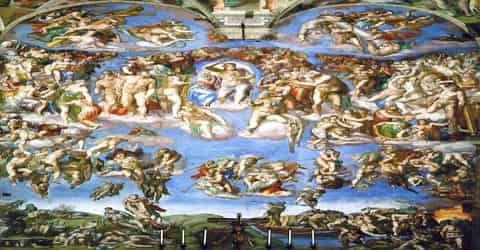
The Last Judgement (1534–1541)
In 1546, Michelangelo was appointed the chief architect of St. Peter’s Basilica, Rome, and devoted himself entirely to architecture and poetry during his later years.
During his life Michelangelo’s major energy in working at St. Peter’s was given to the lower part. He discarded the ideas of the architects who had been working on it just before him, approving only those of the original designer, Bramante. He reverted to the earlier plan for a church with four equal cross arms instead of the more conventional Latin cross plan. He also disliked the quantity of repeated smaller decorative elements added by the most recent architect, which diminished the effect of great size. He modified Bramante’s interior in specifics, making it a more unified space. This is enclosed by huge semicircular sections of wall on the four sides, creating spaces comparable to the hemispherical space inside the dome.
Michelangelo devoted himself almost entirely to architecture and poetry after 1545, including the rebuilding of the Capitol area, the Piazza del Campidoglio, for Pope Paul III. The pope also appointed Michelangelo to direct the work at St. Peter’s in 1546. The enormous church was planned to be an equal-armed cross, with a huge central space beneath the dome. Secondary spaces and structures would produce a very active rhythm. By the time Michelangelo died, a considerable part of St. Peter’s had been built in the form in which we know it.
His last paintings were the frescoes of the Pauline Chapel in the Vatican, which still is basically inaccessible to the public. Unlike his other frescoes, they are in the position normal for narrative painting, on a wall and not exceptionally high up. They consistently treat spatial depth and narrative drama in a way that brings them closer to other paintings of the age than to the artist’s previous paintings. Among the artists, Michelangelo came to know and admire was Titian, who visited Rome during the period of this project (1542–50), and the frescoes seem to betray his influence in color. What was believed to be a self-portrait was discovered in one of these paintings, The Crucifixion of Saint Peter, during a restoration of the Pauline Chapel begun in 2004.
Michelangelo’s sculpture after 1545 was limited to two Pietàs that he executed for himself. The first one, begun in 1550 and left unfinished, was meant for his own tomb. He began the Rondanini Pietà in Milan in 1555, and he was working on it on February 12, 1564, when he took ill. He died six days later in Rome and was buried in Florence.
Death and Legacy
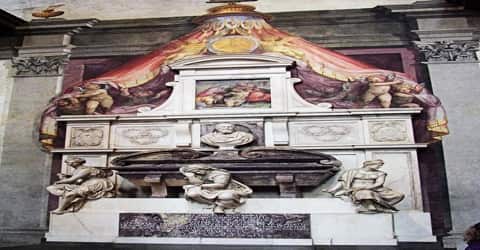
Michelangelo died after a brief illness on February 18, 1564, at his home in Rome, at the age of 88. His body was taken from Rome for interment at the Basilica of Santa Croce, fulfilling the maestro’s last request to be buried in his beloved Florence.
In contrast to the great fame of the artist’s works, their visual influence on later art is relatively limited. This cannot be explained by hesitation to imitate an art simply because it appeared so great, for artists such as Raphael was considered equally great but were used as sources to a much greater degree. It may be instead that the particular type of expression associated with Michelangelo, of almost cosmic grandeur, was inhibiting. The limited influence of his work includes a few cases of almost total dependence, the most talented artist who worked in this way being Daniele da Volterra. Otherwise, Michelangelo was treated as a model for specific limited aspects of his work.
His most ambitious project was the design of the Sistine Chapel’s ceiling which contains over 300 figures. Although the original plan was to paint 12 apostles, he proposed a more complex scheme which resulted in a supreme work of High Renaissance art incorporating the Christian symbology and prophecy.
While Michelangelo’s David is the most famous male nude of all time and destined to be reproduced in order to grace cities around the world, some of his other works have had perhaps even greater impact on the course of art. The twisting forms and tensions of the Victory, the Bruges Madonna, and the Medici Madonna make them the heralds of the Mannerist art. The unfinished giants for the tomb of Pope Julius II had a profound effect on late-19th- and 20th-century sculptors such as Rodin and Henry Moore.
In the 17th century, he was regarded as supreme in an anatomical drawing but less praised for broader elements of his art. While the Mannerists utilized the spatial compression seen in a few of his works, and later the serpentine poses of his sculpture of Victory, the 19th-century master Auguste Rodin exploited the effect of unfinished marble blocks. Certain 17th-century masters of the Baroque perhaps show the fullest reference to him, but in ways that have been transformed to exclude any literal similarity. Besides Gian Lorenzo Bernini, the painter Peter Paul Rubens may best show the usability of Michelangelo’s creations for a later great artist.
Information Source:
